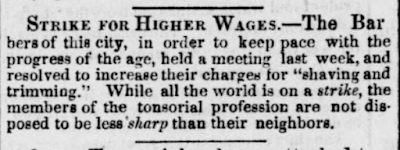In my seemingly never-ending search for information on antebellum black barbers in the mid-South, I felt that I had exhausted my search on platforms that allow for key-word searches. However, recently a friend sent me an article from the early twentieth-century newspaper that used the term "tonsorial artist" in reference to a barber. I had come across that particular phrase in other advertisements and articles a few times, but until today, for some reason, I never thought to use it as search term.
As I've mentioned in other posts on this subject, during the antebellum period, it was common for barbers to spend as much or more time shaving customers than cutting their patrons' hair. Although they might have charged less for shaving services than hair cuts, shaves came much more frequently. I thought there might be a connection to tonsorial and tonsils, being that that area prominently receives shaving. There might be something there, but it appears that tonsorial is taken more as an archaic synonym for barbering or shaving.
Well, it didn't take me long to try. I searched 1850s Virginia newspapers this afternoon in the Chronicling America newspaper feature on the Library of Congress website. I turned up three references in the Richmond Daily Dispatch.
The first one that I found was in the February 7, 1857 edition and came in the form of a traditional advertisement. The McNaughton brothers in Richmond sought to remind citizens of that city that they maintained their shop on 12th Street below Duval's Drug Store. There they offered the normal barbering services, including dying hair.
The next notice I located appeared in the March 7, 1854, issue. The editor stated that Richmond's barbers, almost all of whom were African American, showed solidarity by meeting and resolving to increase their prices for shaves and haircuts. The brief article ends with a pun and insinuated that black barbers took notice of other workers whose labor was in demand and that fact proved that "members of the tonsorial profession" were as "sharp" or perceptive as others who demanded higher wages for their work.
I wonder if a newspaper posting such as this last one, which did not take on the traditional appearance of a classified advertisement as shown at top, was paid for by Cook, or if it was run as a type of public service announcement. Regardless, all of these newspaper appearances show that black barbers were visible businessmen who contributed valuable services to their local communities.











No comments:
Post a Comment